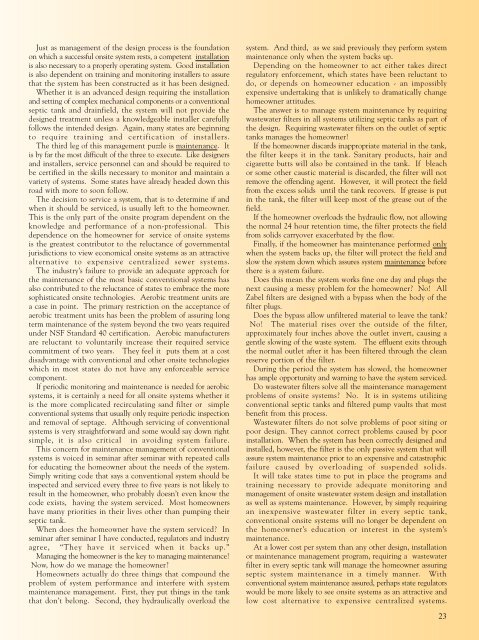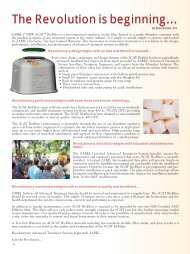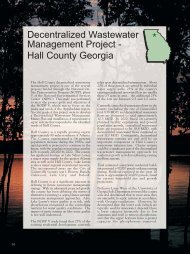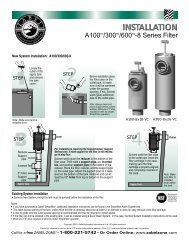Protecting our World's Ground Water - Zabel
Protecting our World's Ground Water - Zabel
Protecting our World's Ground Water - Zabel
- No tags were found...
You also want an ePaper? Increase the reach of your titles
YUMPU automatically turns print PDFs into web optimized ePapers that Google loves.
Just as management of the design process is the foundationon which a successful onsite system rests, a competent installationis also necessary to a properly operating system. Good installationis also dependent on training and monitoring installers to assurethat the system has been constructed as it has been designed.Whether it is an advanced design requiring the installationand setting of complex mechanical components or a conventionalseptic tank and drainfield, the system will not provide thedesigned treatment unless a knowledgeable installer carefullyfollows the intended design. Again, many states are beginningto require training and certification of installers.The third leg of this management puzzle is maintenance. Itis by far the most difficult of the three to execute. Like designersand installers, service personnel can and should be required tobe certified in the skills necessary to monitor and maintain avariety of systems. Some states have already headed down thisroad with more to soon follow.The decision to service a system, that is to determine if andwhen it should be serviced, is usually left to the homeowner.This is the only part of the onsite program dependent on theknowledge and performance of a non-professional. Thisdependence on the homeowner for service of onsite systemsis the greatest contributor to the reluctance of governmentaljurisdictions to view economical onsite systems as an attractivealternative to expensive centralized sewer systems.The industry’s failure to provide an adequate approach forthe maintenance of the most basic conventional systems hasalso contributed to the reluctance of states to embrace the moresophisticated onsite technologies. Aerobic treatment units area case in point. The primary restriction on the acceptance ofaerobic treatment units has been the problem of assuring longterm maintenance of the system beyond the two years requiredunder NSF Standard 40 certification. Aerobic manufacturersare reluctant to voluntarily increase their required servicecommitment of two years. They feel it puts them at a costdisadvantage with conventional and other onsite technologieswhich in most states do not have any enforceable servicecomponent.If periodic monitoring and maintenance is needed for aerobicsystems, it is certainly a need for all onsite systems whether itis the more complicated recirculating sand filter or simpleconventional systems that usually only require periodic inspectionand removal of septage. Although servicing of conventionalsystems is very straightforward and some would say down rightsimple, it is also critical in avoiding system failure.This concern for maintenance management of conventionalsystems is voiced in seminar after seminar with repeated callsfor educating the homeowner about the needs of the system.Simply writing code that says a conventional system should beinspected and serviced every three to five years is not likely toresult in the homeowner, who probably doesn’t even know thecode exists, having the system serviced. Most homeownershave many priorities in their lives other than pumping theirseptic tank.When does the homeowner have the system serviced? Inseminar after seminar I have conducted, regulators and industryagree, “They have it serviced when it backs up.”Managing the homeowner is the key to managing maintenance!Now, how do we manage the homeowner?Homeowners actually do three things that compound theproblem of system performance and interfere with systemmaintenance management. First, they put things in the tankthat don’t belong. Second, they hydraulically overload thesystem. And third, as we said previously they perform systemmaintenance only when the system backs up.Depending on the homeowner to act either takes directregulatory enforcement, which states have been reluctant todo, or depends on homeowner education - an impossiblyexpensive undertaking that is unlikely to dramatically changehomeowner attitudes.The answer is to manage system maintenance by requiringwastewater filters in all systems utilizing septic tanks as part ofthe design. Requiring wastewater filters on the outlet of septictanks manages the homeowner!If the homeowner discards inappropriate material in the tank,the filter keeps it in the tank. Sanitary products, hair andcigarette butts will also be contained in the tank. If bleachor some other caustic material is discarded, the filter will notremove the offending agent. However, it will protect the fieldfrom the excess solids until the tank recovers. If grease is putin the tank, the filter will keep most of the grease out of thefield.If the homeowner overloads the hydraulic flow, not allowingthe normal 24 h<strong>our</strong> retention time, the filter protects the fieldfrom solids carryover exacerbated by the flow.Finally, if the homeowner has maintenance performed onlywhen the system backs up, the filter will protect the field andslow the system down which assures system maintenance beforethere is a system failure.Does this mean the system works fine one day and plugs thenext causing a messy problem for the homeowner? No! All<strong>Zabel</strong> filters are designed with a bypass when the body of thefilter plugs.Does the bypass allow unfiltered material to leave the tank?No! The material rises over the outside of the filter,approximately f<strong>our</strong> inches above the outlet invert, causing agentle slowing of the waste system. The effluent exits throughthe normal outlet after it has been filtered through the cleanreserve portion of the filter.During the period the system has slowed, the homeownerhas ample opportunity and warning to have the system serviced.Do wastewater filters solve all the maintenance managementproblems of onsite systems? No. It is in systems utilizingconventional septic tanks and filtered pump vaults that mostbenefit from this process.Wastewater filters do not solve problems of poor siting orpoor design. They cannot correct problems caused by poorinstallation. When the system has been correctly designed andinstalled, however, the filter is the only passive system that willassure system maintenance prior to an expensive and catastrophicfailure caused by overloading of suspended solids.It will take states time to put in place the programs andtraining necessary to provide adequate monitoring andmanagement of onsite wastewater system design and installationas well as systems maintenance. However, by simply requiringan inexpensive wastewater filter in every septic tank,conventional onsite systems will no longer be dependent onthe homeowner’s education or interest in the system’smaintenance.At a lower cost per system than any other design, installationor maintenance management program, requiring a wastewaterfilter in every septic tank will manage the homeowner assuringseptic system maintenance in a timely manner. Withconventional system maintenance assured, perhaps state regulatorswould be more likely to see onsite systems as an attractive andlow cost alternative to expensive centralized systems.23











